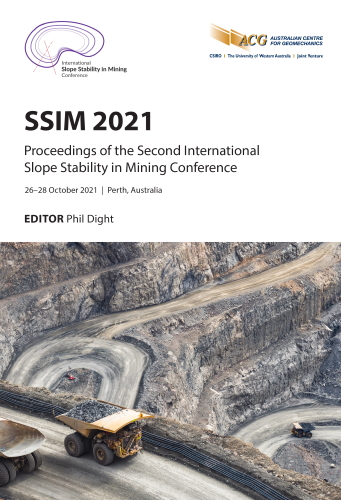Who needs resolution anyway? Three satellite InSAR case studies comparing coincident and contemporary datasets

|
Authors: Holden, D; Cerin, D; Mäkitaavola, K; Ersholm, F; Sjöberg, J |
DOI https://doi.org/10.36487/ACG_repo/2135_12
Cite As:
Holden, D, Cerin, D, Mäkitaavola, K, Ersholm, F & Sjöberg, J 2021, 'Who needs resolution anyway? Three satellite InSAR case studies comparing coincident and contemporary datasets', in PM Dight (ed.), SSIM 2021: Second International Slope Stability in Mining, Australian Centre for Geomechanics, Perth, pp. 211-226, https://doi.org/10.36487/ACG_repo/2135_12
Abstract:
Satellite interferometric synthetic aperture radar (InSAR) is a powerful and economical tool for monitoring ground movement, which benefits from wide coverage, high sensitivity to displacement, and high spatial measurement density, with no need for site access. Currently, there are several options for satellite synthetic aperture radar (SAR) imagery available and numerous missions will be launching over the next few years. A number of satellite parameters have a direct impact on the cost and effectiveness of monitoring programs. This paper presents four case studies that each include results over slope instabilities from multiple contemporary InSAR datasets including data from the TerraSAR-X (TSX), Sentinel-1 (S1), and ALOS-2 satellite constellations. The case study locations include two mines in northern Sweden, Kiruna and Malmberget, and two other sites in the USA; a mine in Nevada and a natural slope in North Dakota. For each of these case studies, the impact of the image resolution on the detection and detail of the displacement areas is compared. While the comparisons focus on the resolution differences, other factors such as the satellite line of sight (LOS), revisit period, sensitivity to displacement, and data cost are also discussed. The two US mine case studies show how TSX data captures higher displacement magnitudes than S1, although the InSAR displacement measurement capabilities of TSX (11 day revisits) are also exceeded. The North Dakota example shows how lower resolution S1 data is unable to detect a smaller but potentially consequential displacement area while 3 m ALOS-2 results do. The examples in Sweden illustrate the higher level of displacement detail in ALOS-2 results compared to S1 results. Some general InSAR monitoring guidelines are also presented relating the surface area of the deforming area to recommended SAR satellite monitoring parameters.
Keywords: InSAR monitoring risk mitigation resolution
References:
3v Geomatics Inc. 2013, RADARSAT-2 Structural Health Monitoring (R2SHM) - Bridge Target Analysis - Milestone 7b, technical report, 3vGeomatics Inc., Vancouver.
European Space Agency 2002a, TSX (TerraSAR-X) Mission, European Space Agency Earth Observation Portal, Paris, viewed 20 October 2019,
European Space Agency, 2002b, COSMO-SkyMed (Constellation o f 4 SAR Satellites), European Space Agency Earth Observation Portal, Paris, viewed 20 October 2019,
European Space Agency 2002c, ALOS-2 (Advanced Land Observing Sattelite-2; SAR mission)/Daichi-2, European Space Agency Earth Observation Portal, Paris, viewed 27 May 2021,
Mäkitaavola, K, Stöckel, B-M, Sjöberg, J, Hobbs, S, Ekman, J, Henschel, M & Wickramanyake, A 2016, ‘Application of InSAR for monitoring deformations at the Kiirunavaara Mine‘, Proceedings of the 3rd International Symposium on Mine Safety, Science and Engineering, McGill University, Montreal, pp. 133–139.
Rabus, B, Werner, C, Wegmueller, U & McCardle, A 2004, ‘Interferometric point target analysis of RADARSAT-1 data for deformation monitoring at the Belridge/Lost Hills oil fields’, Proceedings of the Geoscience and Remote Sensing Symposium, IEEE International, Anchgorage, vol. 4 pp. 2611–2613.
Taylor, K, Ghuman, P & McCardle, A 2016, 'Operational mine monitoring with InSAR', in PM Dight (ed.), APSSIM 2016: Proceedings of the First Asia Pacific Slope Stability in Mining Conference, Australian Centre for Geomechanics, Perth, pp. 695–706,
Thomas, A, Edwards, SJ, Engels, J, McCormack, H, Hopkins, V & Holley, R 2019, 'Earth observation data and satellite InSAR for the remote monitoring of tailings storage facilities: a case study of Cadia Mine, Australia', in AJC Paterson, AB Fourie & D Reid (eds), Paste 2019: Proceedings of the 22nd International Conference on Paste, Thickened and Filtered Tailings, Australian Centre for Geomechanics, Perth, pp. 183–195,
Williams, C, Ross, B, Zebker, M, Gaida, M, Morkeh, J & Robotham, ME 2019, ‘Assessment of historic InSAR monitoring data prior to the Manefay Slide at the Bingham Canyon Mine using the latest analytical techniques’, Proceedings of the 53rd U.S. Rock Mechanics/Geomechanics Symposium, American Rock Mechanics Association, Alexandria.
© Copyright 2025, Australian Centre for Geomechanics (ACG), The University of Western Australia. All rights reserved.
View copyright/legal information
Please direct any queries or error reports to repository-acg@uwa.edu.au
View copyright/legal information
Please direct any queries or error reports to repository-acg@uwa.edu.au